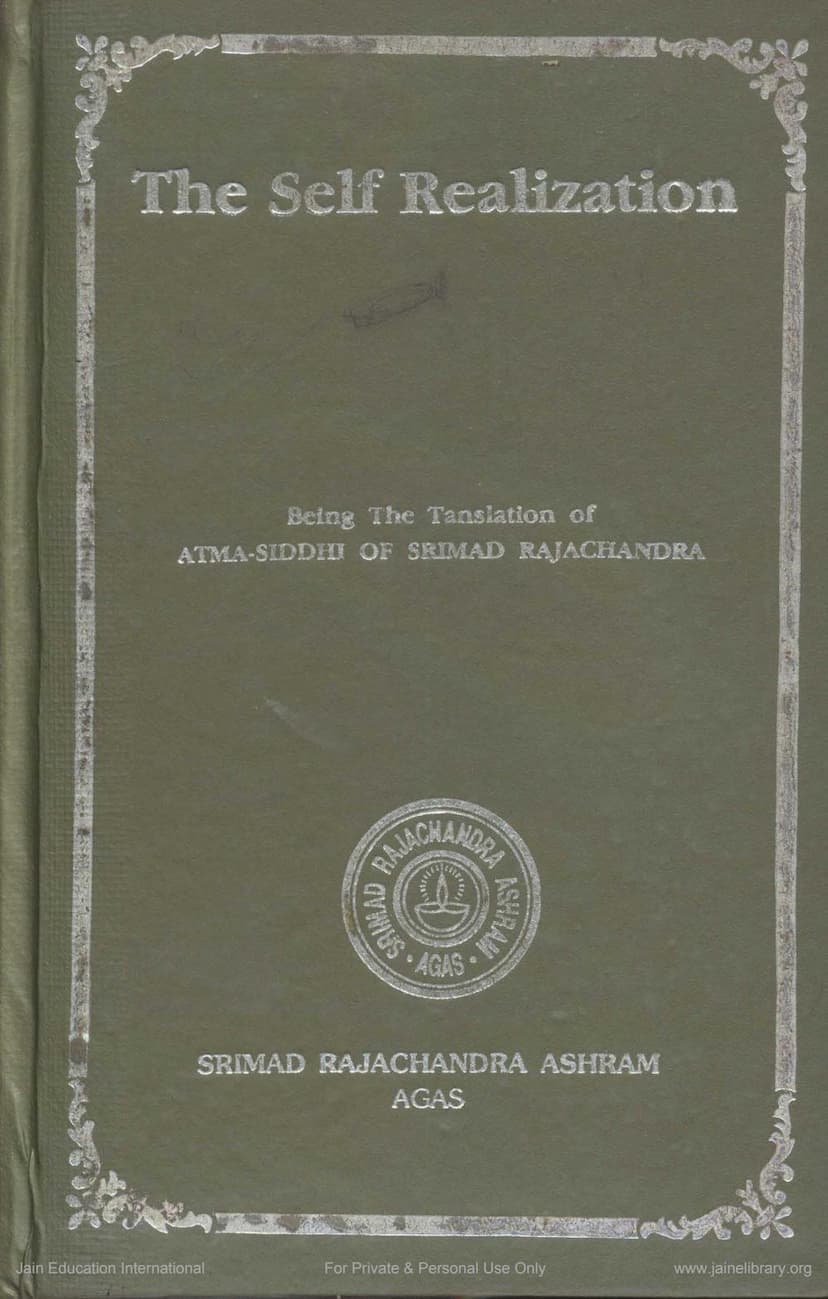Self Realisation
Added to library: September 2, 2025

Summary
The provided text is the English translation of "Atma-Siddhi Shastra" by Shrimad Rajachandra, titled "The Self Realization." The book aims to present the profound philosophical truths about the soul and its liberation in a way accessible to English-speaking spiritual seekers.
Here's a comprehensive summary of the text:
Core Message and Purpose:
- Self-Realization as the Goal: The central theme of the book is the attainment of Self-realization, which is the ultimate goal of human existence. This involves understanding the true nature of the soul and liberating it from the cycle of birth and death.
- Universality of the Message: The teachings are presented as universally applicable, transcending sectarianism. They focus on fundamental philosophical truths and practical methods for spiritual advancement.
- Critique of Superficial Practices: The text critiques two prevalent but ultimately ineffective approaches to spiritual seeking in the current age:
- Ritualism (Kriya-jada): Those who focus solely on external rituals and practices without inner understanding or transformation.
- Pedantic Knowledge (Shushka-jnana): Those who accumulate theoretical knowledge about the soul and scriptures but lack practical application and inner transformation.
- Importance of a True Guru: A recurring and strongly emphasized point is the indispensability of a living, enlightened Guru for spiritual guidance. The Guru's role is crucial in dispelling doubts, correcting misconceptions, and guiding the aspirant on the right path.
Key Concepts and Doctrines (The Six Fundamental Truths):
The book is structured around a dialogue between a disciple and a Guru, addressing six fundamental truths about the soul. These truths form the bedrock of true spiritual understanding and practice:
- Existence of the Self: The Soul exists. It is distinct from the body, senses, and breath. The existence of the Soul is inferred from consciousness, the ability to know, and its presence as the ultimate seer.
- Permanence/Eternity of the Self: The Soul is eternal and indestructible. Unlike the physical body or material objects, the Soul is not subject to birth, death, or decay. Its nature is unchanging consciousness.
- The Self is the Author of its Actions: The Soul, through its consciousness and will, is the initiator and author of its actions (karma). It is not merely a passive spectator or an uncaused entity.
- The Soul is the Enjoyer/Sufferer of its Actions: Since the Soul is the author of its actions, it naturally experiences the consequences (fruits) of those actions, whether they are virtuous or non-virtuous. This is explained through the law of cause and effect.
- The Soul Can Be Liberated: Despite being bound by actions and their consequences, the Soul has the inherent capacity to be liberated from this cycle. Liberation is not an impossible dream but a reachable state.
- There is a Path to Soul's Liberation: A definite and universally applicable path exists to achieve this liberation. This path involves understanding the true nature of the Self and diligently following the prescribed means.
The Path to Liberation:
The book elaborates on the path to liberation, which essentially involves:
- Dispelling Ignorance: The primary obstacle to liberation is ignorance (ajnana) of one's true Self. This ignorance is likened to darkness that is dispelled by the light of knowledge.
- Destroying Bondage Causes: The root causes of bondage are identified as attachment (raga), hatred (dvesha), and ignorance (ajñana). The path to liberation involves destroying these causes.
- Cultivating Virtues: A true spiritual aspirant (mumukshu) must cultivate virtues such as compassion, peace, equanimity, forgiveness, truthfulness, renunciation, and non-attachment.
- Following the Guru's Guidance: Absolute adherence to the teachings and guidance of an enlightened Guru is paramount. The Guru provides the correct understanding and the means to achieve Self-realization.
- Right Faith and Conduct: Liberation is achieved through a combination of right faith (samyak-darshana) and right conduct (samyak-charitra), which stem from the knowledge of the Self and the Guru's teachings.
- Detachment and Non-Identification: Ultimately, liberation comes from realizing the Self as distinct from the body, mind, and worldly possessions, and cultivating a state of non-attachment to all that is not the Self.
Life and Teachings of Shrimad Rajachandra:
The book also includes an extensive "Life of Shrimad Rajachandra," detailing his remarkable spiritual and intellectual journey from childhood. Key aspects highlighted include:
- Exceptional Intellect and Memory: Shrimad Rajachandra displayed extraordinary intellectual abilities and memory from a very young age, including possessing "Jati Smarana Jnana" (knowledge of past lives).
- Spiritual Inclination from Youth: Despite his worldly talents, he had a deep spiritual inclination, exploring various religious paths before finding his spiritual home.
- Influence on Mahatma Gandhi: The text notes his profound influence on Mahatma Gandhi, who considered Shrimad Rajachandra his friend, philosopher, and guide.
- Literary and Philosophical Works: It details his various writings and compositions, including "Atma-Siddhi Shastra," which aim to guide seekers toward spiritual liberation.
- Emphasis on Personal Effort and Detachment: His life exemplified detachment, renunciation, and unwavering focus on Self-realization.
- Honesty in Business: He was also an honest and reliable businessman, demonstrating that ethical conduct and spiritual pursuit can coexist.
In essence, "The Self Realization" is a profound Jain scripture that provides a clear, logical, and practical roadmap for spiritual seekers aiming to understand the true nature of the soul and achieve liberation, emphasizing the essential role of a true Guru and diligent self-effort.